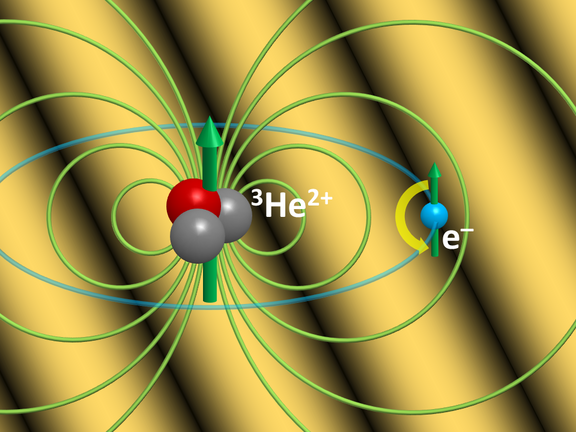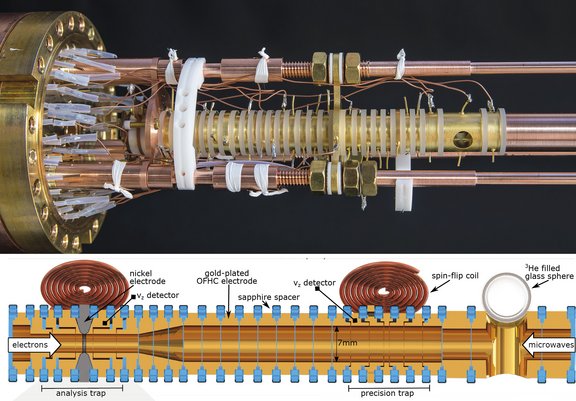The precise knowledge of the magnetic properties of matter on an atomic/nuclear level is of great importance for fundamental physics as well as for applications like Nuclear Magnetic Resonance (NMR) probes. Charged particles with an inherent angular momentum (spin) act like a tiny magnetic needle. The proportionality of magnetic moment (strength of the magnetic field) and spin is given by the so-called g-factor which is a property of the specific particle and its environment. An atomic or nuclear angular momentum is quantised: in particular, the spin of the electron (as well as for the nucleus) in 3He can be orientated either parallel or anti-parallel to an external magnetic field.
The magnetic interaction of 3He is threefold (Fig. 1): In an external magnetic field, the magnetic moment orientation of the electron/nucleus can be parallel or antiparallel to the field lines. In addition, there’s the magnetic interaction between electron and nucleus (so-called hyperfine splitting). This leads to overall four energy levels depending on the electronic and nuclear spin orientation. Transitions between them (corresponding to a spin-flip) can be resonantly induced by microwave radiation. This allows for a highly precise measurement of the resonance frequencies, from which the g-factors as well as the hyperfine splitting for a given magnetic field can be directly deduced.
For the experiment, the researchers of the division of Klaus Blaum at MPIK together with collaborators from the University of Mainz and RIKEN (Tokyo, Japan) used a single-ion Penning trap (Fig. 2) to measure the transition frequencies between the hyperfine states and simultaneously the magnetic field, via the accurate determination of the cyclotron frequency of the trapped ion. Antonia Schneider, first author of the article, describes the setup of the trap: “It is placed inside a 5.7 Tesla superconducting magnet and consists of two parts: a precision trap for the measurement of the ion frequencies and the interaction with the microwave radiation and an analysis trap to determine the hyperfine state.” For each transition, the spin-flip rate reaches a maximum at resonance. The g-factors and the zero-field hyperfine splitting are then extracted from the analysis of the resonance curves. The new experimental setup improves the precision for the g-factors by a factor of 10 to the level of 10–10.
“In order to extract the g-factor of the bare nucleus in 3He2+ from the measured nuclear g-factor in 3He+, one has to take into account the diamagnetic shielding of the electron, i.e. its magnetic response to the external field”, explains Bastian Sikora from the division of Christoph H. Keitel at MPIK. The theoreticians determined the shielding factor with high precision using highly accurate quantum electrodynamic (QED) calculations. Within the same theoretical framework, they also calculated the bound electron g-factor for 3He+ and the zero-field hyperfine splitting. All theoretical and experimental results are consistent within the corresponding accuracy which has been improved for the experimental zero-field hyperfine splitting by two orders of magnitude. The latter was used to extract a nuclear parameter (Zemach radius) characterizing the nuclear charge and magnetization distribution.
In the future, the researchers plan to improve the measurements by reducing the magnetic inhomogeneity of the precision trap and more precise magnetic field measurements. The new measurement method can also be applied to determine the nuclear magnetic moment of other hydrogen-like ions. A next step is a direct measurement of the magnetic moment of the bare 3He nucleus in a Penning trap with a relative precision on the order of 1 ppb or better by implementing sympathetic laser cooling.
This work was performed within and supported by the Max Planck, RIKEN, PTB Center for Time, Constants, and Fundamental Symmetries.
Original publication:
Direct measurement of the 3He+ magnetic moments
A. Schneider, B. Sikora, S. Dickopf, M. Müller, N. S. Oreshkina, A. Rischka, I. A. Valuev, S. Ulmer, J. Walz, Z. Harman, C. H. Keitel, A. Mooser and K. Blaum
Nature, 08.06.2022, DOI: 10.1038/s41586-022-04761-7

